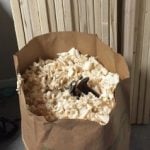My version of a work bench.
Welcome! / Forums / General Woodworking Discussions / Projects / My version of a work bench.
- This topic has 42 replies, 8 voices, and was last updated 7 years, 2 months ago by
Richard Guggemos.
-
AuthorPosts
-
19 October 2016 at 7:43 pm #141632
Well, I’ve started. Space is at a premium (although it will get better later) so my benchtop will be 5’6″ x 18″ + tool well.
The original plan called for repurposing some well weathered cedar. Some of this material had bad pockets so I picked up some studs at Lowes, and plan to alternate cedar with HemFir. The bench will be in the basement of an air conditioned home, and there is a separate dehumidifier in the basement, so I hope not to have temp/humidity fluctuations that will cause problems with the dissimilar materials.
Now for a few questions:
1) Is it crazy to consider of expanding the top by a few inches beyond the well? The thought is to make the well 12″ shorter than the top. At each end, the top would have 6″ lengths where it extends the width of the well, and then another 3″ width of full length beyond the well. I’d put some stiffeners on the underside between the main top and the outboard area. Is this worthwhile? For Paul-type projects, will the extra width be useful? Is it just as useful to simply add 3″ to the main top and hange the well beyond that? Please share your thoughts.
2). I considered using holdfasts to avoid the cost of a good quick-release vise. My projected project cost is currently $50 + workholding. Have any of you gone down this route (only using holdfsts)? If so, any regrets or advice.Thanks for all input.
19 October 2016 at 7:47 pm #141633Glue-up started today. Glue on-hand limited this to about half the top. Guess I’ll have to start buying larger bottles. The first photo is the floor is after moving the clamped up boards. The second shows my cedar/HemFir combination curing.
Attachments:
You must be logged in to view attached files.
You should try to wipe off all that excess glue–it gums things up and takes much longer to cure. Plus it creates a mess and can be an eye sore after it’s dry when trying to smooth it all out. Paul’s technique of using a handful of shavings to wipe up the superfluous squeeze out seems to work pretty well (and it avoids introducing water to your build which could potentially cause other issues). Keep up the good work–so rewarding when you are finished!
21 October 2016 at 1:57 pm #141718So the width is now up to 15-1/2″.
With each round of laminating, I rough the surfaces flat. Here the top is about half way, with the bottom yet to go.
My current thinking is the 18-20″ plus tray is wide enough.
Now it time to sharpen the planes.
Rick G
Attachments:
You must be logged in to view attached files. 21 October 2016 at 8:06 pm #141730
21 October 2016 at 8:06 pm #141730I think the alternating colors will look sharp. I have one comment about glue-up. Since your clamps have such a small clamping surface, you could put a small piece of scrap wood between the clamp face and the boards being glued together. That will spread out the clamping force and avoid making depressions in your wood surface.
21 October 2016 at 11:54 pm #141755Thanks, gOod point about the clamps. I think the outer laminations (in particular) deserve an undimpled apprearance.
It’s fun to watch two parallel shavings come off the plane, one brown and one blond.
Lots more planing to go.

Richard, my work area is a second bedroom, space is extremely limited so I make due with a 4 foot bench with a 12 inch top and an 8 inch well. I’ve been able to make some sizeable pieces with this small bench. On a few occasions I’ve had to rearrange my workspace to accommodate specific tasks, but overall the small bench seems capable of doing quite a bit. I think it would be limited if I tried making a large 6 or more person dining table or other very large pieces of furniture.
22 October 2016 at 5:09 am #141777Dave,
Thanks, that’s just the sort of data point I’m looking for. It really helps.
Rick G
23 October 2016 at 4:20 am #141806Just a little cup left to remove. Then add a few more laminations and repeat.
Now it’s on to planning the legs and face board. Preferably with a minimum of metal hardware, but also capable of sufficient disassembly as to move with the bench at some future time.
I will be setting up for a pair of Gramarcy holdfasts. And I have two smaller face vises which will also be fit. But plans will also account for someday installing a larger Record QR.
BTW, a few years back, someone was clearing out Record machinist vises. I assume this was related to liquidation and sell out to Irwin. I bought a new 5-1/2″ new Record machinist vise w/QR for $49. It’s solid – wish they were still in business.
I better wrap up here, if you have any ideas or experience to lend to my design process, please speak up.
Rick G
Attachments:
You must be logged in to view attached files.24 October 2016 at 4:28 am #141850Tonight I planed the top surface to within about a 1/16th in any direction. It probably won’t stay like that over time, but I wanted to start with the best accuracy I can achieve. Tomorrow the remaining laminations go on and get leveled to the rest.
After that, things park while I review the videos about the legs and consider my options for these and the front apron. It’s going to feel strange not pushing the plane for a couple of hours every evening.

Hi Richard,
Had to type this after seeing your photos. I love the dark and light stripes; mkaes me wish I’d done something like that.
If you’re still looking for data regarding sizes, I originally built my beck 6 feet long by nearly 3 feet deep. The tool well was 11″ wide. I never really felt comfortable using it until I reduced the depth to 25″ and reduced the tool well to 6″. I’ve since built a cover for the well to see if I need it and I really don’t miss it at all so far. If I doo need it, the cover just pops right off again.If I were building a bench now, I’d opt for a 5 foot long one by two feet deep and no tool well. My bench is just a bit too big for the space available so I can’t lay out the shop the way I’d really like it.
We live and we learn…
Keep up the good work, I shall follow this thread with great interest.
Jon
25 October 2016 at 2:42 am #141890Jon,
Thanks for your input re sizing. That’s the kind of info I’m looking for – and it helps to hear about your experience.
The stripes came about by accident. I was using some old wood (the dark stripes) but found about half of it unsuitable and had to fill in with something newer. But I too like the effect and am glad it turned out this way.
Best,
Rick G
25 October 2016 at 2:58 am #141891A #5C showed up in the mailbox today. It’s a Siegley, which in my case means it’s a Stanley with a different name on the Cutting Iron.
What a difference compared to a #4 for big work! It appears to have features parallel to a Stanley type 9, which might suggest that is was made between 1902 and 1907. OTOH, I don’t think Stanley bought out Siegley until 1910 and I don’t think they changed the Lever Iron to the Stanley style until the buyout. So perhaps for marketing reasons they left off the frog adjusting screw on Siegleys.
In any case, it has a nice patina. The finish on the tote is pretty. I think this had relatively little use. But it had clearly been tuned by the owner and put away with plenty of oil (and some sawdust). After a quick hone of the blade, it was off to the races. It may be the best $35 I’ve spent.
I’ve attached pix of mixed wood shavings.
-
This reply was modified 7 years, 9 months ago by
Richard Guggemos.
-
This reply was modified 7 years, 9 months ago by
Richard Guggemos.
-
This reply was modified 7 years, 9 months ago by
Richard Guggemos.
Attachments:
You must be logged in to view attached files.26 October 2016 at 8:16 pm #141939Had a few free hours this morning and got to work. Double checked the top surface and dusted off a few spots. I don’t think the bottom is parallel to the top. Trying to decide how important this is, apart from the contact areas for the legs.
Speaking of which, I got the first two legs glued up. I also began flattening the first surface of the front apron. It’s a 2×8. A 2×4 will be laminated below to give a nominal 2×10 front apron.
For a while I was resisting a rear apron. But the more I tried designing around it, the more complicated the design became. The rear apron will be another 2×8, and down low there will be a 2×6 stretcher.
I’m borrowing Derek Long’s (and others?) design where the rear apron is the back of the tool well and effectively expands the size of the bench top.
Hoping to get back to it for a few hours this evening.
Attachments:
You must be logged in to view attached files. -
This reply was modified 7 years, 9 months ago by
-
AuthorPosts
- You must be logged in to reply to this topic.
